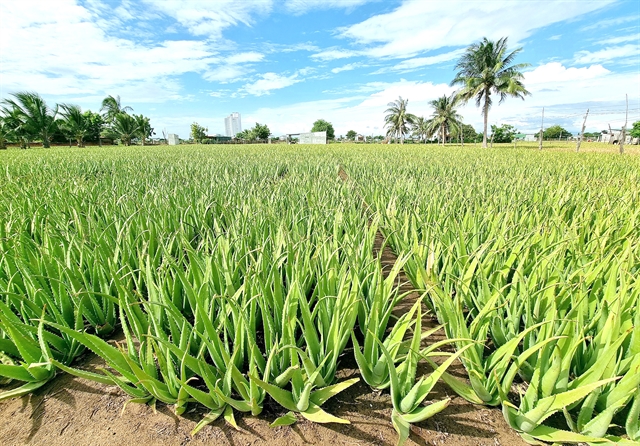 Society
Society

 |
| A concentrated aloe vera farming area in Phan Rang-Tháp Chàm City’s Văn Hải Ward in Ninh Thuận Province. — VNA/VNS Photo Nguyễn Thành |
NINH THUẬN — Ninh Thuận Province is expanding organic farming of some key agricultural products and establishing linkages between various stakeholders to improve efficiency.
The south-central province will focus on rice, cashew, fruits, vegetables, sugarcane, asparagus, aloe vera, medicinal plants, goats, sheep, poultry, fish, shrimp, bivalve mollusks and seaweeds, according to its Agriculture and Rural Development.
Trương Khắc Trí, deputy director of the department, said the province is prioritising concentrated organic farming areas depending on weather and soil.
It would establish farming areas for indigenous products with the potential to obtain geographic indications and for organic farming, he said.
It plans to develop organic farming of crops on more than 5,000ha and aquatic species on 25ha by 2025, he added.
Lê Huyền, deputy director of the provincial People’s Committee, said advocacy would be strengthened to enhance public awareness of organic products and their importance.
Linkages would be developed among various stakeholders to create organic value chains, he added.
Effective switching
Ninh Thuận has used ineffective rice fields and orchards for growing plants and high-value fruits with the use of advanced farming techniques.
The country’s largest grape producer is expanding the cultivation of new and high-quality varieties such as NH01-152 pink grape, NH04-102 black finger grape and Mẫu Đơn.
Trần Thị Thu Hạnh was one of the first farmers in Ninh Sơn District’s Nhơn Sơn Commune to grow NH01-152 pink grape in a polygreen house to Vietnamese good agricultural practices (VietGAP) standards.
Grapes planted in polygreen houses are safe from the impacts of rain, wind, dew, and diseases, she said.
It has an annual yield of 1.2-1.5 tonnes per 1,000 square metres, she said.
With its outstanding colour and quality, it fetches VNĐ120,000-140,000 (US$5-6) per kilogramme in the market, two or three times the price of traditional varieties, she said.
She is expanding the cultivation of NH01-152 and other new grape varieties, she added.
Farmers growing new grape varieties in polygreen houses to VietGAP standards earn VNĐ1-1.2 billion ($42,000-50,000) per hectare per year.
The province is expanding the cultivation of nine new table and wine grape varieties to diversify produce and compete with imported grapes.
To increase value, more and more farmers are switching to crops that suit local conditions and help save water and adapt to climate change.
In winter-spring 2022-23, nearly 405ha of lands where rice and other crops were grown were converted and other high-value crops were grown in their place.
It has encouraged farmers to increase the use of efficient irrigation to cope with drought and now has more than 1,770ha of plant growing areas equipped with such equipment.
The cultivation of other crops on erstwhile rice fields has reduced the use of water by 25-30 per cent, according to the department.
The income from growing jujube and grapes is 15.6 times and 16.8 times higher than growing two rice crops a year, while green bean, sesame and corn fetch 1.4-5.2 times the income, it said.
The province is developing linkages in agriculture by establishing co-operatives and co-operative groups and tie-ups between them and companies.
Participating farmers enjoy steady prices and demand and 15-20 per cent higher incomes.
It has 35 such models for rice, corn, asparagus, grape, and vegetable farming.
It has developed a similar number of large-scale rice fields with a total of 4,719ha by pooling small farmers’ lands.
Đặng Kim Cương, director of the department, said the province is restructuring farming to adapt it to climate change and increase added value, mobilising investment in agriculture, zoning concentrated growing areas, and developing linkages between various stakeholders.
The country’s driest province plans to restructure around 3,200ha of farmlands, including 1,525ha of rice, by 2025.
It will prioritise for drought-resistant plants with high economic value such as grape, jujube, asparagus, corn, green bean, grapefruit, banana, durian, and mango.
This year, it is spending VNĐ21 billion ($870,000) on the national new-style rural area programme, focusing on concentrated farming, high-quality agricultural produce and the use of VietGAP and organic standards.
It will create favourable conditions for investments in hi-tech agriculture and develop farm-based tourism.
It aims to develop at least four hi-tech agriculture areas spreading over 1,000ha by 2025. VNS




